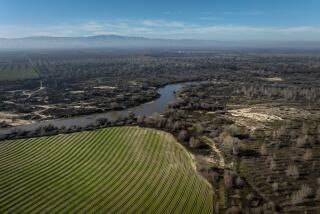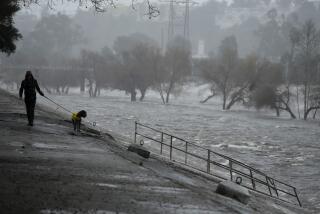Deliberate flooding of Atchafalaya River Basin puts wildlife on the run
When confronted with rapidly rising floodwaters, wild animals tend to react the same way humans do. They run for high ground.
That unsurprising fact of nature has added a new complexity to the daily efforts of Travis Dufour, a Louisiana state wildlife biologist. He spends his days in a pickup truck, bouncing along levees and farm roads in search of displaced deer, black bears, alligators, wild turkeys, feral hogs and the occasional armadillo.
Mostly, Dufour rides herd on deer. It’s his job to keep deer and people — and especially motor vehicles — from colliding as deer flee the impending Great Flood of 2011.
“Look! Right there. … Two of ‘em,” Dufour said as his camouflaged state pickup lurched along the top of the towering East Protection Levee in the soggy Atchafalaya River Basin.
Two young male whitetails leapt from the high grass and bounded away, their tails flapping like white flags.
“They just pop up out of nowhere,” Dufour said.
By the time deer and other wildlife fight their way out of the rapidly flooding basin, they’re exhausted. Deer, feral hogs and other critters often flop down on the levee and rest for an hour or more, stressed and terrified.
“I saw a wild pig laying down there yesterday. An armadillo, too,” Dufour said.
When disturbed by humans, the animals hightail it — often straight back into dangerous floodwaters or smack into cattle fences on the levees. That’s why state officials have closed off the two big levees that run the length of the basin like a pair of raised backbones.
Some people love to watch a good flood, so curiosity seekers have flocked to the levees to see the water rise — at least until the police and wildlife officers closed access roads and posted checkpoints.
“We’re trying to cut down on human and wildlife interaction,” said Dufour’s boss, Fred Kimmel, assistant administrator of the wildlife division of the state Department of Wildlife and Fisheries, who was along on the patrol.
Along U.S. Highway 190, near the top of the basin, the speed limit has been lowered to 45 mph. Flashing electronic signs read: “Caution: Wildlife Crossing.”
Wild animals are bounding across the bayou to escape floodwaters, which oozed and gurgled below the earthen levee near Maringouin, about 20 miles west of Baton Rouge.
A few miles north, the Morganza Spillway was opened a week ago, deliberately flooding 1.3 million acres in the thinly populated basin to save Baton Rouge and New Orleans from devastating floods.
Below the levee late last week, you could see clear backwater from the overflowing Atchafalaya River mingling with churning brown Mississippi River water released at Morganza.
“That was dry land when I drove by here yesterday, Fred,” Dufour said, peering down from the top of the levee at swirling waters that swallowed trees, swamps, fields of winter wheat, soybeans and sugar cane, and an outhouse or two.
The floodwaters destroy animals’ habitat — not just during the flood but long afterward, by killing the vegetation the animals feed on. Black bears are displaced to feed from garbage cans in backyards. Deer forage on soybeans and other crops, infuriating farmers.
The state has dispatched 205 wildlife enforcement agents in 103 vehicles to handle wildlife driven from normal habitats.
Dufour, 31, an easygoing Louisiana State University graduate, has been driving back roads since the spillway opened. He can tell you that deer love poison ivy, that bears and deer can swim like fish and that what locals call flamingos are actually roseate spoonbills.
At the East Protection Levee, Dufour hopped out of his truck — a roomy Ford with a “Don’t Trash Louisiana” bumper sticker.
He stomped through a soybean field and noticed that deer had foraged on the emerging green plants. At the tree line, a startled deer burst from a soggy marsh and fled.
“I saw a bunch of deer here this morning. They’re all in the tree line now, resting,” he said.
As the floodwaters churn southward, more animals will be forced out of the basin and into forests, farms and communities. They’re already stressed by a drought that has reduced vegetation.
“Kinda ironic, having a drought in the middle of a big flood,” Dufour said.
He’s especially worried about black bears, an endangered species in Louisiana.
And the flood is driving feral hogs, which are formidable breeders and foragers, into surrounding farmlands. They devour wild turkey eggs at the height of the current nesting season, Dufour said, and generally create a nuisance everywhere they go.
For particularly cantankerous wildlife, he carries a shotgun loaded with buckshot. Wildlife agents also carry tranquilizer guns for what Kimmel calls “bear issues.”
Dufour drove on, scanning tree lines and sugar cane fields for wildlife. He noted where wild animals were, where they had been and where they appeared to be going after escaping the flooded basin.
Across the levee, graceful white egrets unfurled their wings and floated lazily above the roiling waters. Black-bellied whistling ducks and blue-winged teals paddled happily in the muck.
The day wore on. The waters flowed inexorably south, swelling the basin. Deer rested in the shadows, and a turtle slowly waddled across the levee.
“So far, so good,” Kimmel said. “With the slow water release, we haven’t had a lot of wildlife mortality, or a lot of vehicle impact.”
But “we’re just getting started,” Kimmel said, watching the basin fill. “There’s a lot more water to come.”
More to Read
Start your day right
Sign up for Essential California for news, features and recommendations from the L.A. Times and beyond in your inbox six days a week.
You may occasionally receive promotional content from the Los Angeles Times.







